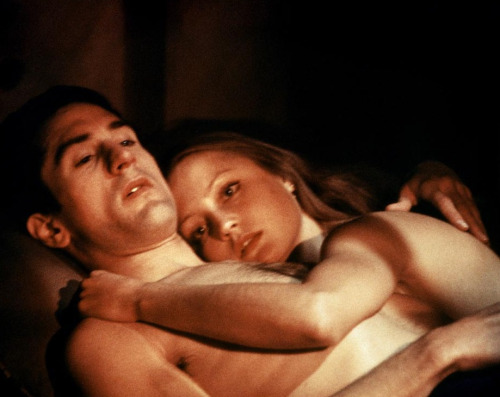The Last Tycoon (1976)

The Last Tycoon was the final work by author F. Scott Fitzgerald; unfinished due to Fitzgerald’s death by heart attack, the book was “completed” as best it could and in 1976, Hollywood decided to take on the unfinished novel and turn it into an unfinished movie. Hollywood is deathly afraid of being too critical of itself, and various Hollywood-based films have generally underwhelmed (or been outright torturous in some cases). The Last Tycoon is one of the better films, if wobbly in its execution, but with a cast of heavy-hitters – New and Old Hollywood – it’s worth taking a risk.
Hollywood producer Monroe Stahr (Robert De Niro) is the “boy wonder” for his studio due to his massive success at a young age. When he falls in love with the mysterious Kathleen Moore (Ingrid Boulting) his obsession with her threatens to bring ugly things from his past to the surface.

The period of 1930s filmmaking is the focus when making movies about Hollywood, a safely ensconced “time gone by” reminding audiences that Hollywood is seemingly better now. Monroe Stahr, a recreation of Irving Thalberg, controls the studio with an iron fist and fails to fall to vices like drinking and women; a problem for fellow studio head Pat Brady (a still gorgeous Robert Mitchum). It’s not to say Stahr doesn’t have problems. As with almost all Hollywood tales, he’s got a problem with women. Not just one, but two women invade Stahr’s life: the coy Kathleen Moore who might be involved in a relationship – she’s so coy I was confused as to whether she was married or not throughout the entire film; and Cecilia Brady (an All-American Theresa Russell), Pat’s daughter. The Brady relationship runs underneath the Stahr storyline and I wanted a movie focusing there, especially because Russell and Mitchum play the father-daughter duo with an incestuous relationship so undisguised it’s practically blatant.
The Hollywood scheming and wheeling-dealing is where the attacks hit home. The script, written by legendary writer Harold Pinter, bites as it explores the unfinished dream (represented by Stahr’s beach house as well as the source material) within the duplicity of Hollywood. The high point is Stahr’s attempts to invigorate staid British writer Boxley (Donald Pleasence) into loving movies. De Niro’s frantic speech is award-worthy as he sets the scene for Boxley, and the audience in a later iteration of the speech where he breaks the fourth wall, with such imagination that Boxley is tempted to look at something he knows isn’t there. Stahr’s ability to “make pictures” is magnetic and I can’t fathom any other actor who could make me believe in pictures like De Niro.
As Stahr De Niro is stoic and repressed, but can produce cringes, especially during a drunken fight with a union representative (played suavely by Jack Nicholson). However, the movie turns into dull sentimentality upon introducing the love story. Ingrid Boulting is a beautiful woman, and her character acts as a composite of Stahr’s first wife (now deceased) which has potential, but director Elia Kazan is more interested in lingering on Boulting’s body and face more than anything. I’m not averse to nudity, but the way Boulting gallivants on-screen in the buff feels scummy. The sheer happiness supposedly derived from her being naked and wearing an apron – a male fantasy of domesticity – provides little purpose and comes off as an attack on the Women’s Lib movement of the time. The movie’s twist should be a gut-punch to the audience, particularly if you read it like I did – without spoiling too much, Kathleen could be a plant devised by Brady – comes off as another wild fantasy of Stahr’s.
The problem lies within the unfinished source material itself. Kazan and Pinter tried to work around the gaps in storytelling by inserting abrupt transitions and cuts. There are a few early transitions presented as a movie Stahr is overseeing – starring Tony Curtis and Jeanne Moreau – but they’re just scenes with no set-up. In fact, if you didn’t realize the film within a film parodied Casablanca, you’d assume someone mixed in the movie with a remake of the Humphrey Bogart starrer. There’s also no detailing of Stahr’s past wife outside of a shrine devoted to a Jean Harlow/Carole Lombard lookalike (audiences in the know are aware of Thalberg’s real-life marriage to actress Norma Shearer who outlived him). The emphasis on the love story yanks the audience out of the Hollywood angle, forcing them to realize how incomplete the narrative truly is.

I wouldn’t call The Last Tycoon an unfinished masterpiece as it’s called by some, more an unrealized experience. The potential and acting is evident, but the narrative turning Stahr into a man with humanity is lifeless. The beauty of the time period remains, and coupled with the brilliant cast of Hollywood stars – several doing their best work before old age – turns The Last Tycoon into a movie with unrealized, and limitless, potential.
Ronnie Rating:

Interested in purchasing today’s film? If you use the handy link below a small portion is donated to this site! Thanks!
Kristen Lopez View All
Film Editor at TheWrap. Author of the book "But Have You Read the Book: 52 Literary Gems That Inspired Our Favorite Films," put out by TCM and Running Press. Book 2, focused on disability in film, comes out via Applause Books in 2025.
I think this movie would have fared better without the Monroe-Kathleen love story. It really dragged this film.
LikeLike
My new hot project|enjoy new website
http://sims3shemale.shemalepaysite.miaxxx.com/?asia
matute mom tube porn white gay porn cuckholding porn porn tiger o porn eskimo
LikeLike